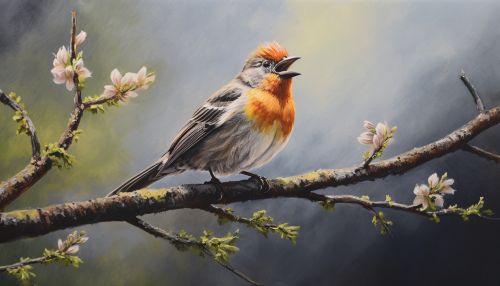Animal vocalization
Introduction
Animal vocalization refers to the creation of sounds by animals. This is a form of communication that is used by a wide range of species, from insects to mammals. The sounds produced can serve a variety of purposes, including attracting mates, warning of danger, or expressing emotions. The study of animal vocalization is a complex field that involves understanding the physiological mechanisms of sound production, the behavioural contexts in which sounds are used, and the evolutionary pressures that have shaped these vocal traits.
Physiology of Vocalization
The physiological mechanisms that allow animals to produce sounds are diverse and often species-specific. In mammals, vocalization typically involves the larynx, a structure in the throat that contains the vocal cords. When air from the lungs passes over the vocal cords, they vibrate, producing sound. The pitch and volume of the sound can be modified by changing the tension and position of the vocal cords, as well as the amount of air pressure applied.
Birds, on the other hand, use a specialized organ called the syrinx for vocalization. Located at the base of the trachea, the syrinx is capable of producing a wide range of sounds, from simple calls to complex songs. Unlike the mammalian larynx, the syrinx can produce two independent sounds simultaneously, allowing birds to create harmonies and intricate melodies.


Insects often produce sounds through a process known as stridulation, which involves rubbing together certain body parts. For example, crickets produce their characteristic chirping sound by rubbing their wings together, while grasshoppers make sound by rubbing their hind legs against their wings.
Behavioural Contexts of Vocalization
The behavioural contexts in which animals use vocalization are diverse and often species-specific. One common use of vocalization is in mate attraction. In many species, males will produce elaborate songs or calls to attract females. These vocal displays can signal the male's health, fitness, and genetic quality to potential mates.
Vocalization is also commonly used for territorial defence. Many animals will produce loud, aggressive calls to warn off intruders and signal their ownership of a particular area. These territorial calls can prevent costly physical confrontations and help to maintain social order within a species.
Alarm calls are another important form of vocalization. When a predator is spotted, many animals will produce a specific call to warn others of the danger. These alarm calls can vary in complexity, from simple, broad-spectrum warnings to complex signals that convey specific information about the type and location of the threat.
In some species, vocalization is used to maintain social bonds and cohesion within a group. For example, dolphins and whales use a variety of clicks, whistles, and songs to communicate with each other and maintain group cohesion. Similarly, many bird species use contact calls to stay in touch with each other while foraging or migrating.
Evolution of Vocalization
The evolution of animal vocalization is a complex and fascinating field of study. It is believed that vocalization evolved as a form of communication that could convey complex information over long distances, and in environments where visual signals may be ineffective.
One key factor in the evolution of vocalization is sexual selection. In many species, males with the most elaborate and attractive songs or calls are more likely to attract mates and reproduce. This can lead to the evolution of increasingly complex and elaborate vocal displays.
Natural selection also plays a role in the evolution of vocalization. Animals that can effectively use vocalization to warn of predators, defend territories, or maintain social bonds may have a survival advantage, leading to the spread of these vocal traits within a population.
